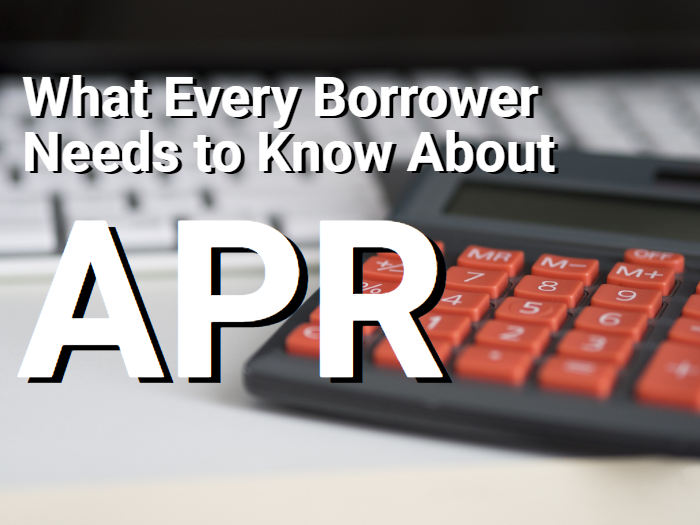Whether you are borrowing money for a new fridge or a million-dollar home, you will likely come across the term “APR.” You hear it on auto commercials and on signs for furniture stores; you’ll also see it when researching mortgages.
While APR matters for all forms of debt, because of the larger amounts, understanding how it impacts your home mortgage loan is especially important.
To understand APR, you have to understand the math behind it. But don’t worry, this is actually a simple, easy-to-use formula.
APR and Your Loan
APR: What Does it Mean?
APR is a acronym for “Annual Percentage Rate,” and it is the number that tells you how much will be added to the loan over one year. APR is essentially the price of borrowing money, and it is quoted in terms of an interest rate or percentage. It’s important to understand APR, because slight differences can have a profound impact on the amount you pay over the life of your loan.
Here’s a simplified example: say you have a loan balance of $100 with a 10% interest rate (which would be extremely high given today’s rates). Over a single year, 10% of $100, or $10, would be added to the balance, so your balance would go up $110. The simple calculation is to multiply the balance ($100) by .10 (10%). The percentage is converted into decimal format to make the calculation easier.
Again, this is a simplified example. In a mortgage, you would have tens or hundreds of thousands of dollars (or even millions) plus fees and expenses. Also, the APR would not be a well-rounded number like 10%, but rather a detailed number like 4.63%. This complicates the math, but the equation essentially stays the same.
APR is always a yearly rate, describing how much you’ll pay over the course of a year. With other types of debt, such as credit cards, you might pay it off over a shorter time frame. To get precise numbers on these types of loans, a bit more math is required.
Understanding 0% APR
Although they are rare in the mortgage-lending industry, you may have seen 0% interest advertised for a wide range of products, such as vehicles, televisions, and furniture. These teaser deals suggest that no interest will be paid on the money you borrow, and some are advertised as “same as cash,” implying that you’ll pay the same amount as if you were paying in cash upfront.
However, it’s important to remember that while 0%-interest deals can help you avoid interest, they likely come with other fees and expenses. 0%-interest deals could also be deferred interest, meaning you won’t pay interest at first, but you will eventually, especially if you fail to pay off the loan after a certain period.
APR for Mortgages
Compared to auto loans and credit-card debt, the APR on mortgages can be fairly complex. While it’s meant to be a balanced comparison for all the costs of the loan, including interest, closing, insurance, and fees, different lenders will include different fees from the APR calculation. For this reason, you can’t always count on APR to tell you the complete story of your loan.
There will be many factors that change your APR, so it’s important that you understand these issues and make smart choices so you have the best deal on your mortgage loan.
What Factors Change Your APR?
Your APR can change, and these are some of the most important factors that will impact your rate…

The Loan Type: Quite frankly, some loans have higher costs than others. Home loans and auto loans usually come with the lowest rates compared to credit-card and consumer debt. This is because home and auto loans are secured, meaning a physical item, which the lender can reclaim if needed, is attached to the loan. Even if you are looking at mortgages alone, the type will impact the APR. For example, an FHA loan and a jumbo loan will each come with different rates.
Loan-to-Value: The loan-to-value (LTV) ratio is a statement that demonstrates the total amount of the loan compared to the value of the house. If a home is worth $100,000, and the loan is also $100,000, the LTV is 100%. However, if the loan is $75,000, the LTV is 75%. In general, lenders like to see a low LTV, usually capping the amount at 95%. If you have a low LTV for your loan, you will likely have a lower APR.
Debt-to-Income: For obvious reasons, lenders want to know how much money you make. But arguably just as important (if not more so) is the amount you make compared to the amount you owe, which is known as your debt-to-income (DTI) ratio. This ratio is calculated monthly, so it doesn’t look at your debt total, but merely your monthly debt payments. For example, if you make $10,000 a month, and you have monthly debt payments of $2,500, your monthly debt total is 25%. The higher your DTI goes, the greater the risk to lenders. Therefore, if you keep your monthly debt load down, you can likely get a better APR on your mortgage.
Personal Credit Score: Although the overall impact of your credit score on the mortgage APR can be slightly overrated (some act as if it’s the only factor), it still remains an important number for lenders, no matter what type of loan you need. Your total credit history will tell lenders whether or not your are a trustworthy borrower, so having a sustained history of repayments can make borrowing on a home much faster, easier, and more convenient. Getting a home loan without a credit score is still possible, but the better your score, the lower you APR will be.
Providing Reliable Information on Your APR
If you want more information on APR and how it affects your mortgage, contact San Diego Purchase Loans today. We’ll make sure you understand APR and how it will change your total mortgage payments.


